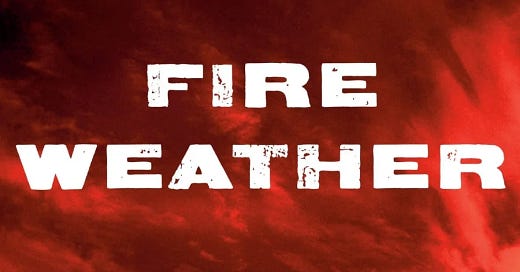The Petrocene: How We Created an Age of Fire
Fire Weather: A True Story from a Hotter World by John Vaillant
The Fort McMurray wildfire, also known as the "Beast," was an unprecedented catastrophe that unfolded in Alberta, Canada, in 2016. This devastating event serves as a case study illustrating the alarming consequences of a warming world. The fire, driven by a combination of climate change and dry weather conditions, engulfed the region and forced nearly 90,000 people to flee their homes. Entire neighbourhoods were reduced to ashes, leaving a trail of destruction in its wake.
The city and the surrounding landscape had become something akin to a fire planet—not a biome but a “pyrome” whose purpose was not to support life but to enable combustion.
Fire has played a pivotal role in human evolution, shaping culture and civilization for hundreds of millennia. However, in the face of intensifying climate change, we witness its destructive power unleashed in unforeseen ways.
Vaillant’s main argument in "Fire Weather: A True Story from a Hotter World" is that humanity is facing an unprecedented challenge due to the escalating impacts of climate change, particularly the increasing frequency and intensity of wildfires. The fossil fuel industry, aptly described by Vaillant as the "fire industry," extracts substances from the ground to be burned, contributing to global warming. This warming effect exacerbates the risk of wildfires, which can devastate forests.
Moreover, the extraction of fossil fuels often leads to deforestation, which further contributes to climate change. Trees, acting as natural carbon sinks, absorb CO2 from the atmosphere, mitigating global warming. However, deforestation not only diminishes the number of trees available to absorb CO2 but also releases stored carbon back into the atmosphere, amplifying the warming effect In Africa, for instance, 30% of oil and gas fields overlap with forests, leading to significant deforestation.
"Fire Weather" is not just a recount of a disaster; it's a profound critique of the oil industry and an exploration of our relationship with the environment. Vaillant gives a damning history of the Canadian oil sands industry, highlighting the scale of the industry required to distil something usable from such a resource. The book is a profound critique of the oil industry, its intertwined history with climate science, and how the capitalist world has been bingeing on fossil-fuelled combustion for a century.
Vaillant presents the Fort McMurray wildfire as a tangible manifestation of the ‘Petrocene Age,’ an era defined by humanity's excessive reliance on fossil fuels. As temperatures rise and weather patterns become increasingly extreme and erratic, the risk of wildfires escalates, threatening ecosystems and human lives.
The first plume, which was growing steadily larger, was actively changing the region’s meteorology. No longer simply a ground-level interface fire, it had become a force of Nature. As temperatures rose past 1,000 degrees Fahrenheit, the air at the smoke column’s center rose ever more rapidly, driving upward like smoke up a hot chimney. As this superheated air rose higher and faster, it created a vacuum into which cooler air was drawn from all sides at greater and greater velocity. Operating like a recirculating fountain, storm systems this large also generate powerful downdrafts along their outer edges, which, in the case of a wildfire, can cause it to burn even more intensely, like an atmospheric turbocharger.
2023 has been the deadliest year this century for forest fires; they destroyed nearly 400 million hectares (988 million acres) of land around the world, killed more than 250 people, and emitted 6.5 billion tonnes of carbon dioxide. Canada experienced its worst fire season ever, with 18 million hectares burned by the end of the year, driven by climate change and dry weather conditions.
John Vaillant’s meticulously researched book encapsulates the urgency of addressing climate change and rethinking our relationship with fossil fuels. He does not offer any solutions, but we know what we have to do. It’s simple: Leave fossil fuels in the ground.
Governments play the most crucial role in implementing significant climate action. However, individual actions and habits also matter. We just cannot afford to sit back and wait for governments to act. Each one of us must ask ourselves: What kind of world do we want for ourselves and our children? And then act accordingly.
Thank you for reading this Substack. If you think someone else might enjoy this too, please spread the word. If you have any feedback, please comment below.
Additional Information:
The Fort McMurray wildfire in 2016 was one of the costliest natural disasters in Canadian history, with an estimated $9.9 billion in damages.
The fire burned for approximately two months before it was fully contained.
Climate change is projected to increase the frequency and intensity of wildfires worldwide.
The impacts of wildfires extend beyond immediate destruction, including environmental degradation, economic losses, and adverse health effects from smoke inhalation.
Transitioning to renewable energy sources and implementing sustainable practices can help mitigate climate change and reduce the risk of wildfires.




